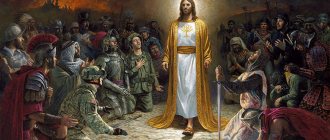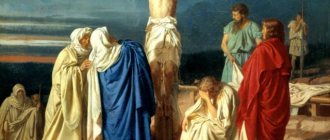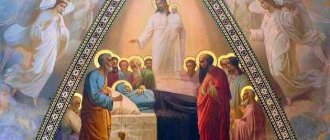The land in which the events related to the topic of our lesson today took place is called Palestine. It was inhabited by the Jewish people, who were divided into 12 tribes. In the 6th century BC. e. Palestine was captured by the Babylonians, and the Jews were resettled in Babylon. Many years later they were freed by the Persian king Cyrus. He allowed them to return, but since there was very little fertile land in Palestine, many chose not to return. Thus, the first diaspora arose. Subsequently, after the conquest of Alexander the Great, Jews settled throughout the Hellenistic world.
Synagogues
The centers of Jewish communities were synagogues, where Jews gathered for prayers on Saturdays. They were separated from the rest of the pagan world by their reluctance to worship pagan gods and their belief in their one god, the creator of the entire world around them. These features attracted the attention of the pagans. Someone accused the Jews of godlessness, and someone who was more educated and familiar with the works of Greek philosophers said that the Jews are a people of philosophers. The fact is that by that time the Greeks also came to the idea that there is not a set of gods, but a single god.
Articles of Faith in Early Christianity
At this point, from the very first steps of Christianity, a discrepancy arose, which was the reason for numerous Christological (better to say Trinitarian - from the Trinity) disputes that lasted for centuries and gave rise to many schisms. We are talking about one God in three persons - God the Father, God the Son and God the Holy Spirit.
We will return to these disputes later. But for now, let us note that faith in one God and the Holy Trinity, a pious life, repentance of sins with soul-easing confession and hope for the kingdom of heaven after death, and especially the second coming of Christ and the Last Judgment - this is the basis of what everyone should have accepted. These commandments of early Christianity became the foundation of a new religion, and they quickly gained wide popularity, and adherents of Christianity began to spread throughout the empire.
The emergence of Christianity
In the 1st century BC. e. in the Roman Empire, the fashion for all sorts of exotic oriental religions would spread. In particular, adherents of Judaism will appear. It is in this environment that the newly emerging religion - Christianity - will spread.
In the 1st century BC. e. The Romans captured a small independent country - Judea. The cruel king Herod began to rule it. The cruel king Herod ruled Judea under the Roman emperor Augustus. When Herod died, the Romans disposed of the conquered territories as follows: Galilee came under the rule of Herod’s son, Herod Antipas, and Judea began to be ruled by Roman governors, who were called prefects, and later, procurators. The internal affairs of the Jews were handled by a council - the Sanhedrin, which consisted of priests and champions of antiquity. They were called Pharisees.
Forms and directions of early Christianity
Almost precisely at this early stage of development in various Christian communities, the foundations were laid for the mixture of real facts of the recent past with the mythical and poetic heritage, which then acquired the features of a reliable legend, which has already been mentioned in passing.
The process of formation of a new religion, especially after the appearance and, especially, the canonization of the Gospels and other texts of the Christian New Testament, numerous variations and deviations could not but interfere. This meant that the original diversity of opinions, rituals and dogmas in numerous communities had to be eliminated, replaced by the canonical rigidity of a new and ambitious religion. This was approximately the main trend in the development and transformation of early Christianity, in which at first two opposing movements clearly stood out - pro-Jewish, represented, in particular, by the Apocalypse, and anti-Jewish, associated primarily with the activities of the Apostle Paul and his disciples.
The pro-Jewish trend soon died out, and Paulinism spread and became the internal basis of Christianity. It was within the framework of Paulinism, with its thesis that for Christianity there is neither a Greek nor a Jew, that God pleases everyone, circumcised and uncircumcised, that there was a final break in the new monotheistic religious system with the national limitations inherent in Judaism. This kind of rethinking of Christianity in the spirit of Paulinism became the starting point of its transformation towards an organized universal church. In this sense, Paul could be considered the first patriarch, if not the founder of Christianity as a new monotheistic universal religion. The schism, even the antagonism, between Christianity and Judaism originates from Paulinism.
Paulinism contributed to the switching of the radical activity of its adherents from criticism of the existing order in Rome to criticism of the rival religion, whose representatives were now guilty of all sins and even crimes - they, after all, crucified Christ. In addition, Paulinism placed a sharp emphasis on reward after death, on rewarding patience and suffering with bliss in the next world. These two very significant innovations played an important role in the process of the entire further transformation of early Christianity.
Who told about the birth of Christ
For us, the birth of Christ divided all history into two parts - before the Nativity of Christ and after the Nativity of Christ. Four evangelists told us about the birth, life, death, and resurrection of Christ: Matthew, Mark, Luke, and John. Believers religiously believe every word that has come down to us in the New Testament.
Insofar as they see the greatest feat in the life, death and resurrection of Christ. He is the one who gave people eternal life. Before following Christ, Matthew was a publican, collecting taxes for Rome. As for Mark, he joined the Christian community when he was still at a very young age. He will write his gospel based on the memoirs of the Apostle Peter. As for Luke, he was a doctor and painter from Antioch. Subsequently, he will be recognized as the first icon painter. John, before following Jesus, was a fisherman.
Confrontation between secular authorities and the church
In the 11th century, it becomes clear that the poor cannot feed themselves, and people's morals are deteriorating. In this regard, the Cluny reform was carried out. Its summary is as follows: the reform completely cleared the monastic charter, celibacy was also approved (but priests could take a housekeeper, who was actually a common-law wife for them), monasteries were directly subordinate to the pope.
The Roman patriarch began a war against kings, using excommunication as a weapon. Both monarchs and entire states were excommunicated, as a result of which people could not marry or bury their dead. Churches were closed, children were not baptized.
Birth of Jesus Christ
What did the evangelists talk about? During the census organized by the Roman authorities, a couple went from Nazareth to Bethlehem. It was Joseph and Mary. Mary was expecting the birth of a baby. She was predicted that the baby she would give birth to would become the savior of the world. When the couple reached Bethlehem, it turned out that they had nowhere to stay. I had to spend the night in a den, in a cave. There the baby Jesus was born. His birth was accompanied by a strange phenomenon - a bright star rose in the east and this star showed the way to three shepherds and three wise men, who brought their gifts to the born one.
By the age of thirty, Jesus would be baptized by John the Baptist. He will travel a lot, preach, work miracles. He will be followed everywhere by 12 disciples - the apostles, those who will subsequently spread his teachings to all ends of the earth. What did Christ teach? Things that are very complex and very simple. Do not repay evil for evil, do not offend others, and then through faith, through love for God, the gates of the kingdom of heaven will open for a person.
Execution of Christ
A week before the Jewish holiday of Passover, Jesus Christ and his disciples arrived in the city of Jerusalem. He was greeted enthusiastically, however, his opponents were unhappy. They saw Jesus as just one of many impostors. Another man who claims to be the son of God. As a result, one of Christ’s disciples, Judas, was bribed. He betrayed him.
Jesus was captured and executed by the verdict of the Sanhedrin. This sentence was approved by Pontius Pilate, the Roman governor. After the execution took place, one of the most terrible and shameful executions, the body was given to the disciples of Christ. They put him in a cave, not far from Golgotha, the mountain where the execution took place. When on the third day the followers of Christ came to anoint the body with fragrant oils and bury it, it turned out that the stone that had previously covered the entrance to the cave had been rolled away, and an angel was sitting in the place where the body had once lay. The angel told them that Christ had risen.
Jesus Christ appeared to his disciples for another 40 days, until he ascended to heaven, entering the Mount of Olives. Some believe what the evangelists say literally to the last word, while others are critical. But in any case, few doubt the fact of the existence of Jesus, called Christ.
The birth of Christianity. Earlier Christianity. The first seven Christian Ecumenical Councils.
Along with Buddhism, Christianity is one of the world religions with the largest number of supporters. Christianity is a collective term to describe three main movements: Orthodoxy, Catholicism and Protestantism.
At the center of Christianity is the image of the God-man - Jesus Christ, who through his martyrdom on the cross suffered for the sins of mankind, but thereby removed these sins from them and reconciled the human race with God. And with his resurrection, he opened for those who believed in him a new life, a path to reunification with God in the Divine Kingdom. Christ is translated from Greek as “anointed one,” “messiah,” savior. With this common name, Jesus Christ is associated with the Old Testament legends about the coming to the land of Israel of a prophet, a messiah, who will free his people from suffering and establish there a righteous life - the kingdom of God.
The holy book of Christians is the Bible, which consists of two parts. The Old Testament is the sacred book of the followers of Judaism and the New Testament, which sets out the most important stages in the life of the creator of Christianity - Jesus Christ and the main provisions of his teaching.
Christianity arose in the 1st century. AD on the territory of the Eastern part of the Roman Empire in Palestine. The new era begins its countdown from the time of the birth of Jesus Christ.
We learn the Christian version of the life, work and teachings of Jesus Christ from three types of sources. The first type is the canonical books of the New Testament. They are called canonical because their text was recognized as “inspired by God.” Non-canonical writings are not considered “inspired” but are not rejected by Christian churches. These are “The Gospel of Nicodemus”, “The First Gospel of Jacob the Jew”, “Books about the Nativity of the Virgin Mary”, “Books of Joseph the Carpenter”, “Teachings of the 12 Apostles”, etc.” The third category of Christian sources is the writings of the “church fathers” - early Christian thinkers, defenders and propagandists of the Christian doctrine in the first two centuries of its existence: Justin Martyr, Irenaeus, Tatian, Tertullian, Clement, etc.
Christ is born in Bethlehem. This justifies the words of the Jewish prophet Micah, who said that a leader would come out of Bethlehem who would save the people of Israel. “The Magi came to King Herod of the Jews and asked him: Where is he who has been born king of the Jews? For we saw his star in the east and came to worship him.”
Herod was alarmed and all the people of Jerusalem were with him. Having secretly found out from the Magi the time of the appearance of the star, Herod ordered to find the baby. “The star that we saw in the east kept walking in front of them until it finally came and stopped where the baby was.” Then the wise men saw the baby with Mary, bowed to him, gave him gold, frankincense and myrrh, and left for their own country.
In a dream, Joseph receives orders from an angel of the Lord to flee with the baby and his mother to Egypt, since Herod is going to kill the Christ child. Herod orders the death of all infants under 2 years of age. And when Herod dies, the angel again appears in a dream to Joseph in Egypt and orders him to go to the land of Israel. Joseph then receives orders in a dream to go to the Land of Galilee and settles in the city of Nazareth.”
Evangelist Luke believes that the parents of Jesus, Mary and Joseph, always lived in the city of Nazareth and ended up in Bethlehem in connection with the census. According to the decree of Emperor Augustus on the census, each family had to come to the city where the head of the family was from. Joseph was from Bethlehem and therefore he ended up there with his pregnant wife, who there gave birth to a son, Jesus.
Some discrepancies between the two Gospels also appear in the presentation of the genealogy of Jesus. The Gospel of Matthew adjusts the genealogy of Jesus to a special kind of trinity - All genera from Abraham to David - 14, from David to the deportation to Babylon -14, from the deportation to Babylon to Christ -14. According to this genealogical chain, it turns out that Jesus is a descendant of the Jewish kings: David, Solomon and Rehoboam. In other words, the Messiah predicted by the prophets, the savior of the people of Israel. Evangelist Luke carries out the same version, but it turns out that only 28 generations passed from David to the birth of Jesus Christ.
These and other inaccuracies and contradictions in the New Testament, as well as problems of interpretation of biblical texts, have given rise to doubts regarding the historicity of the image of Jesus Christ.
The 18th century French thinker C. Du Pius sought to prove that Jesus Christ is a solar deity borrowed by Christianity from Eastern religions and that all the events of his life set out in the gospels should be perceived as astral allegories.
Another, historical school, considered Jesus Christ to be a real person, a preacher of a new religion, who formulated a number of fundamental ideas that laid the foundations of Christianity; the disciples did not renounce their teacher.
The first step towards this historical reconstruction should be a statement of the fact that Christianity originated in the Jewish environment and this environment left a deep imprint on many provisions of the Christian doctrine. As the Bible indicates, Jesus Christ was born into a Jewish family. His earthly parents Mary and Joseph were devout Jews and sacredly observed all the requirements of their religion. The very title of Jesus “Christ” - meaning “messiah”, “savior” - is based on the deeply rooted teaching in Judaism about the messianic role of the Jewish people, on the fact that it is from this environment that the savior of humanity will appear.
Messianic sentiments among the Jews were constant, but their manifestation at different historical periods of time was not the same. During the period of social stability, “law” ascended to first place, and messianic expectations faded into the background. When Jewish society experienced a crisis stage of its development, messianic sentiments awakened and actively spread. In the 1st century n. e. Judea was experiencing an acute crisis associated with pressure on the population from three levels of power: the Roman emperor, his tetrarch governors, King Herod Antipas and the Jewish high priests. Each of these authorities exploited the people, forcing them to pay exorbitant taxes, forcing them to certain forms of behavior, which often contradicted the moral beliefs and beliefs of the Jewish people.
During this period, Messianic hopes were widespread in Palestine; many wandering preachers appeared, proclaiming the imminent coming of the Messiah, the savior of the people, the true king of the Jews. The Bible names two great prophets of that time - Jeremiah and John the Baptist. These preachers sought to attract people's attention with an unusual appearance. Jeremiah preached with a yoke around his neck, John the Baptist wore clothes made of camel's hair, did not cut his hair, lived as a hermit in the desert, ate dried locusts and was very thin. His appearance alone made an indelible impression on people. And his speeches, exposing the moral decline of those in power, the debauchery that reigned in the palaces, and the disregard for the needs and suffering of people, found a lively response among the masses. Those in power were afraid of the sermons of John the Baptist and, as the biblical legend says, his head was cut off by order of King Herod Antipas, provoked to this act by the “belly dance” of his half-daughter Salome.
John the Baptist did not consider himself the messiah, the savior of mankind. According to the biblical version of Christianity, he is only the Forerunner. His task was to prepare the people for the coming of the Messiah. God's judgment, John argued, was not far off. He called on people to repent and take the path of a righteous life. John chose the ritual of immersion in the water of the Jordan River as a symbol of his entry into the messianic era. This immersion was given symbolic meaning. Just as water washes the body, so repentance cleanses the soul. The rite of ablution received the symbolic meaning of baptism (Greek baptizo - Russian baptism) Hence the nickname of John - the Baptist. Before washing, people confessed their sins and cleansed their souls.
The Bible is silent about the life of Jesus until he was 30 years old. And it was with the appearance of Jesus on the banks of the Jordan and his acceptance of baptism from John that his path as a preacher began, ending with death on the cross and miraculous resurrection. After baptism, Jesus withdrew into the desert, where he spent some time alone, preparing himself to serve God. Soon he reappeared on the banks of the Jordan. John the Baptist recognized him and told the people, “Behold the Lamb of God who takes away the sins of the world.” This meant that he declared Jesus to be the messiah and this made people believe in his special calling. A fairly close group of his followers rallied around Jesus, the core of which was the twelve apostles and his closest relatives, as well as Mary Magdalene. Together with this group, Jesus moves around Judea, preaches his teachings, performs all kinds of miracles, helps to be cured of illnesses, etc.
What exactly did Jesus Christ teach? What principles formed the basis of his teaching? We have already noted the Jewish roots of Christianity. Without understanding the existence of a close connection with Judaism, much in Christianity will seem incomprehensible. Christianity emerges as a sect of Judaism. It sets itself the task of cleansing Judaism from those “harmful” layers that were introduced into it by the scribes and Pharisees, who turned living teaching into a system of rigid positions and automatic ritual actions. For the scribes and Pharisees, the letter of the “law” was more valuable than its essence. Christian teaching develops in polemics with the Jewish scribes and Pharisees, although at first it does not claim to be anything primarily new. “Do not think that I came to destroy the law or the prophets; I did not come to destroy, but to fulfill” (Matthew 5:27).
At the same time, the Gospels clearly outline the line of opposition between the new teaching and Judaism. This line is already clearly outlined in the famous Sermon on the Mount of Jesus Christ, which is reproduced in the Gospel of Matthew.
Thus, the main direction in the rethinking of Judaism by Christianity is to deepen the substantive moral principle of religious teaching from the point of view of affirming the leading role of the principle of love. The commandment of love: love for God, love for one’s neighbor, including one’s enemy, is considered by many religious scholars to be the cornerstone of the religious and moral teachings of Christianity.
At the same time, social motives were also quite clearly heard in the New Testament sermon: the idea of the equality of all people before God, the condemnation of wealth, violence, and exploitation. “It is easier for a camel to go through the eye of a needle than for a rich man to enter the kingdom of God.” The social motive was especially clear in the revelation of John the Theologian - the Apocalypse. The entire content of this work is permeated with the idea of \u200b\u200bretribution, which will come at the hour of the Last Judgment. And this judgment, according to the author of the Apocalypse, will come soon, during the lifetime of this generation.
But on the basis of these statements one should not turn the New Testament into a revolutionary manifesto, and declare Jesus Christ a revolutionary, as some left-wing radical theologians have often done in the past and present. Christianity is not a social, but primarily a moral and religious teaching. Jesus Christ taught: Render to Caesar what is Caesar's, and to God what is God's. Nevertheless, the social motives of early Christian preaching had and continue to have a great influence on socio-political movements throughout the world.
The main idea of the Gospel preaching of Jesus Christ was to convey to all people the idea that God - the Father of all people - sent him to announce to people about the imminent establishment of the kingdom of God.
The authorities of Judea and Rome greeted Jesus Christ as an impostor. They accused him of blasphemy and incitement against the authorities and sentenced him to death by crucifixion. The mass of the Jewish people also turned away from him. When the people were asked to choose which of those condemned to death they wanted to pardon, the crowd chose the thief Barrabas over Jesus. Jesus Christ was executed and, as the gospel story says, resurrected on the third day, appeared to his disciples, gave them instructions, and on the 40th day ascended to Heaven.
After the death and resurrection of Jesus Christ, a community of his followers remained in Jerusalem, led by the Apostle Peter. In addition to this community, by the 60s of the 1st century, several other early Christian communities existed in Palestine. The presence of such communities in this territory is confirmed by scientific data. In 1947, near the Dead Sea (Wadi Qumran area), scientists discovered ancient scrolls that became known to the world community under the name of the Qumran manuscripts. These manuscripts told about the settlement of the Jewish sect of the Essenes, which, in many aspects of its doctrine and cult, as well as its way of life, was close to Christianity. Members of this sect called themselves the “New Union”, the “Community of the Beggars”, and their teachings the “New Testament”. The manuscripts speak of a “teacher of righteousness” who spoke of the inevitable end of the world, after which “God will judge human souls according to their faith.” The Essenes were not supporters of the idea that only Jews were God’s special chosen people. They considered the main thing not the ethnic factor, but spiritual unity. This community had simple rituals such as baptism, the breaking of bread, common property, and mutual support of all members.
Now it is important to explain how Christianity grew from a small Jewish sect to the scale of a world religion? Why did the peoples of the Roman Empire, among whom Christianity first began to spread, turn out to be so receptive to this teaching? The theological-theological approach connects this process with the “divine inspiration” of Christian teaching and the activities of the apostles, “ascetics of the faith,” to disseminate it. We do not reject this version. But our task is to reveal those natural, socio-cultural mechanisms that led to the fact that the teachings of the Jewish prophet Jesus became a world religion that had a huge influence on the course of world development.
In religious studies, quite a large number of works have been written on this topic from different positions. A significant role in explaining this process belongs to the German philosopher F. Engels,
who devoted a number of works to this problem:
“Bruno Bauer and Primitive Christianity”, “The Book of Revelation”, “On the History of Primitive Christianity”.
The general conclusion of these works boils down to the idea that by the time the first Christian community arose in Palestine, the public consciousness of the peoples of the Roman Empire was prepared to accept this doctrine.
F. Engels recorded both social and cultural prerequisites for the perception of Christianity. According to him, “Christianity was preceded by a complete collapse of the world order. Christianity was the expression of this collapse” (Marx K., Engels F. Soch. T. 7. P. 21).
By the middle of the 1st century, the time had come when the Romans’ confidence that their world was the best of all possible worlds was a thing of the past, and this confidence was replaced by a feeling of imminent catastrophe, the collapse of centuries-old foundations, and the imminent end of the world. Discontent with those in power is growing among the lower social classes, which periodically takes the form of riots and uprisings. These riots and uprisings are brutally suppressed. Moods of dissatisfaction do not disappear, but they seek other forms of satisfaction.
Christianity in the Roman Empire was initially perceived by most people as a clear and understandable form of social protest. It awakened faith in an intercessor capable of curbing those in power, establishing the idea of universal equality, the salvation of all people, regardless of their ethnic, political and social affiliation. The first Christians believed in the imminent end of the existing world order and the establishment of the “Kingdom of Heaven”, thanks to the direct intervention of God, in which justice would be restored, righteousness would triumph over unrighteousness, the poor over the rich.
Exposing the depravity of the world, its sinfulness, the promise of salvation and the establishment of a kingdom of peace and justice - these are the social ideas that attracted hundreds of thousands, and later millions of followers to the side of Christians. They gave hope for consolation to all those suffering. It was these people, as follows from the Sermon on the Mount of Jesus and the Revelation of John the Theologian, who were primarily promised the Kingdom of God. Those who are first here will be last there, and those who are last here will be first there. Evil will be punished, and virtue will be rewarded, the Last Judgment will be accomplished and everyone will be rewarded according to their deeds.
But this aspect of Christian preaching, which satisfies the social aspirations of the masses, cannot explain the widest influence of Christianity, the significant pace of its spread throughout the Roman Empire in the 1st-2nd centuries. n. e. The reason for this lies in those God-seeking tendencies that were characteristic of Roman society during the period of its deepest crisis. The socio-psychological roots of the search for God of this era should be sought in the mood of helplessness, abandonment, turning into despair and hopelessness, into blind submission to fate. The world around us seemed to the people of that era to be mired in vice and evil, and the ordinary person had no choice but to submit, follow his fate, passively wait and hope for some mystical salvation. In the public consciousness of that time, the idea of fate, destiny, and the inevitability of what is destined from above acquired a dominant position. This idea received its philosophical expression in late Stoicism.
In the interpretation of the Stoics, the world is a single, holistic entity. The one world order exists due to the unity and universality of the divine Logos. The Divine world Logos is the seed of the world, disintegrating into many seeds - Logoi. Each seed contains a thought, a rational principle that predetermines the fate of each part of the whole. Therefore, in its essence, the world Logos is identical to world fate, the divine providence that created the world and governs its existence. “Do you want to call God fate,” Seneca asks and answers, “you won’t be mistaken, because everything depends on him, he is the cause of all causes. If you want to call it providence, it will be true, because its wisdom directs everything, so that there is no disorder in the world, and everything receives a reasonable meaning and explanation. Whether you call it nature, you will not sin against the truth, everything is born from it, it lives by its breath. If you call it peace, you will not be deceived. After all, he is the whole that you see, perfection in all its constituent parts, preserving itself by its own strength.”
Stoicism provided Christianity with not only methodological guidelines for the formation of a worldview, but also a system of moral values. It is characterized by the preaching of apolitism, neglect of the realities of concrete social life, denial of the value of the objective-corporeal and the opposition of the spiritual to the physical as a higher sphere of vital interests. “I am not so small as to be a slave to my body - I look at it as nothing other than a chain that fetters my freedom,” writes Seneca to his friend and patron Lucilius. “Remember,” Seneca urged, “nothing except the soul is worthy of admiration, and for a great soul everything is less than it.”
In his moral sermon, Seneca called for the creation of a special community between people, imbued with an invisible, but the strongest connection - a community of holy righteous people, uniting the divine world and the human world. Such a community, in his opinion, can be created by people who embody the ideals of the sage - the Stoic. These are people free from all kinds of passions and needs, true masters of themselves, possessing all virtues, always doing what is right and achieving all these qualities by an attitude of non-resistance and religious submission to the providential order of the world. “We must imagine in our imagination two states: one that includes gods and people, in which our gaze is not limited to this or that corner of the earth, and the other is the one to which chance has assigned us. There are people who serve both large and small states, and there are those who serve only small ones.” “Undoubtedly,” says Seneca, “the right choice was made by those serving the “big state.” This idea of religious cosmopolitanism was consonant with the expectations of deliverance, the coming kingdom of God, and global religious brotherhood, in the depths of which different tribes and peoples can find a place for themselves. Christianity was also consonant with Seneca’s views on the transience and deceitfulness of sensual pleasures, concern for other people, self-restraint in the use of material goods, the inadmissibility of rampant passions, modesty and moderation in everyday life.
Another equally important contribution to the formation and assimilation of Christian teaching, especially among the intelligentsia, was made by the Jewish philosopher from Alexandria Philo. Philo's philosophy was based on the idea of God as a supreme being, standing outside of time and space, transcendent to the world (located beyond the world). Due to his transcendence, God cannot come into direct contact with the world; for this, an intermediary is needed. At the mythological level, this problem was resolved in Christianity through the image of the lamb - Jesus Christ, who accepted sacrificial death for the sins of mankind in the name of its salvation. However, emerging Christianity needed to provide a solution to this problem on a theoretical level. On this basis, the so-called Christological problem was formed, which stimulated theological searches with particular force and opened up a wide field for philosophical reflection.
In ancient philosophy, certain approaches had already been developed to solve the problem of overcoming the dualism of the world and its essence. The Pythagoreans, Plato and his followers laid down the basic methodological principles of the doctrine of the spiritual unity of the world. But neither the classics of ancient philosophy nor the Neoplatonists created the concept of a personal God. They interpreted deity as a kind of abstract impersonal principle that produced all being from itself. The personal understanding of God was first given by Philo of Alexandria.
“What is a personality is unique and indestructible, not made up of something impersonal,” Philo reasoned. An attempt to explain personality causally and genetically leads to a transition from one element to another, ad infinitum. With this fragmentation, personality is lost. Consequently, in order to preserve the personality in all its individuality, originality and unity, it is necessary to admit that it can be created out of nothing, without any prerequisites. Personality, like God, is without prerequisites. If God is an absolute beginning, then he cannot but be a person, because if he is not a person, then something preceded him, and, therefore, he is not an absolute beginning. Thus, God is a person and requires a personal relationship and understanding.
The characterization of God as a person was a significant step forward in the direction of the Christian worldview, but did not provide a complete understanding of bridging the gap between God and the world. It was necessary to introduce mediating forces. For this purpose, Philo uses one of the central concepts of ancient philosophy - the concept of Logos. Just as in ancient philosophy, Philo’s Logos is endowed with a rational-logical and structural-ordering function. Logos is world order, beauty and harmony. This is the law that brings all the diversity of things to unity. From him is all form, all stability and certainty. Taken by itself, in abstraction from corporeal things, Logos is the kingdom of eternal intelligible ideas, identical with divine thoughts. The world is created by God according to the model of these ideas and serves as a reflection of them.
But unlike ancient philosophy, Philo’s Logos appears as a spirit created by God, which is originally the divine mind. After the creation of the real world, the divine mind became immanent in the world. Accordingly, ideas and logos, as divine components, also become immanent to the world. Philo’s idea of the Logos lacked only its identification with the messiah—Christ. The Logos, identified with Christ, appears shortly after Philo's death in the Gospel of John:
“In the beginning was the Word (Logos in the original Greek), and the Word was with God, and the Word was God” (John 1:1).
And further, the author of the work brings Jesus Christ closer to God through the Logos.
“The Word became flesh and dwelt in him” (John,
^, 4 J. Thus, a version arises that the eternally existing Logos became incarnate in Jesus Christ. Jesus Christ is interpreted as God, but the concept of “God” is not identical to the concept of “Christ” There is a certain difference between them, for otherwise it is difficult to understand the meaning of the earthly existence of the Logos, its purpose and purpose in the world. God the Father is invisible, and the Logos the Son must incarnate among people so that through him they learn about the Father.
Disciples of Jesus Christ
What happened to the students next? Left without their teacher, they were not abandoned. According to legend, the Holy Spirit descended on them, after which, under the pressure of persecution and, in fact, wanting to preach the faith of Christ, they spread to the most remote corners of the earth.
Among Christ's disciples there were many talented preachers. And one of the most talented was the Apostle Paul. During the life of Christ, Paul was not his disciple; moreover, he belonged to the persecutors of Christians. But one day Christ appeared to him and rebuked him. And Paul left everything and went to preach. He is called the apostle of the pagans. The fact is that in his travels he visited Macedonia, Greece, and Asia Minor, and everywhere his sermons were a huge success.
Death and Resurrection of Jesus
Many scholars believe that Jesus died between the ages of 30 and 33, although the exact date is debated among theologians. According to the Bible, Jesus was arrested, tried and sentenced to death. The Roman governor Pontius Pilate issued the order to kill Jesus under pressure from Jewish leaders who claimed that Christ was guilty of various crimes, including blasphemy. Jesus was crucified by Roman soldiers in Jerusalem and his body was placed in a tomb. According to Scripture, three days after the crucifixion, Jesus' body disappeared. In the days after Jesus' death, some people reported sightings and encounters with him. The Bible states that the resurrected Jesus ascended into heaven.
How Christianity Spread
First, Christianity spread throughout the Roman Empire, then from beyond its borders. The growth in the number of Christians attracted the attention of the Roman emperors. Persecution followed. Under Nero, these persecutions were truly terrible. Those who did not renounce were thrown to the beasts and burned alive. Those who did not renounce Christ, but chose death, were later called martyrs.
Under Emperor Diocletian, there was an attempt to solve the problem with Christians radically. Diocletian simply tried to destroy them physically. It didn't work out for him. But in 313, Emperor Constantine, on the contrary, gave Christians the opportunity to freely practice their religion. Moreover, he was even baptized himself. Thus, Christianity became the state religion. The path that the Christian church has traversed is very difficult, tortuous and eventful. The Christian Church survived. It has survived, survived and is, perhaps, one of the few institutions that go back in its development to ancient times.
Formation of the Christian Church
The early Christian church consisted of communities that existed on voluntary contributions. At the head of the community were bishops, assisted by presbyters and deacons. These individuals formed the clergy. This is how the church hierarchy was founded. The clergy eventually received white robes along with the right to perform divine services. There were two main sacraments - baptism and the Eucharist. Since the Eucharist is celebrated in a conciliar manner, Eucharistic meals were the main unifying principle. Christian meetings took place in hidden places. In the 3rd century, images of Christ appeared in the form of a shepherd, the Virgin Mary, St. John the Baptist and the apostles.
For a long time there was no single Christian doctrine. In the polemical struggle of Paul's followers with the Gnostics, who reworked the Christian doctrine in line with pagan philosophy, and sectarians, by the end of the 2nd century, the “true” Christians prevailed, who recognized the authority of the Gospel texts, and considered their opponents to be heretics. During this period, Christian communities already represented a serious social force that even the imperial authorities had to reckon with.
An interesting monument are the canonical books of the New Testament, the four Gospels, the 21 Apostolic Epistles, the Acts of the Apostles and the Apocalypse of John the Theologian. These and other works reflected the protest of the oppressed masses against injustice, eschatological hopes and at the same time dreams of a “golden age”. Such sentiments are characteristic of the time when, on the territory of the Roman Empire, in conditions of a spiritual crisis, the decay of traditional religion, the failure of the official ideology and a painful revaluation of values, there was an intense religious search.









